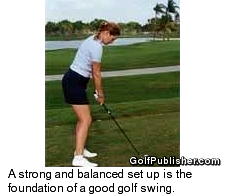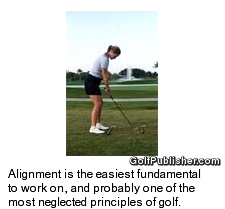Swing essentials demand a solid set-up, alignment and weight-distribution
 In the second part of her "Swing Essentials" series on building a fundamental golf swing, Golf Instructor Karen Palacios-Jansen focuses on the set-up.
In the second part of her "Swing Essentials" series on building a fundamental golf swing, Golf Instructor Karen Palacios-Jansen focuses on the set-up.
Last week I wrote about one of the most important golf Swing Essentials: the grip. This week, I will describe how to address the ball. Everything you do before you swing determines how well you strike the ball. With a poor set-up, even the best golfers in the world will not hit the ball straight. Take the time to set-up correctly for a consistent swing.
How to Set-Up
• A quality set-up is completely relaxed and tension free.
• The stance is about shoulder width, providing a stable base from which to swing.
• Bending from the hip sockets as opposed to the waist will allow you to make a powerful body coil.
• Flex the knees only slightly.
• Let your arms hang naturally, not too close or too far from the body.
Ball Position and Weight Distribution
Ball position and weight distribution are closely related. The distribution of your weight at address can affect your swing significantly. In fact, weight distribution should change to match the shot you are playing.
 With short irons, there is slightly more weight on the lead leg and the ball position is in the middle of your stance. With the rest of the irons and fairways woods, the weight distribution is about even. When driving, there is slightly more weight on the back leg than the front leg.
With short irons, there is slightly more weight on the lead leg and the ball position is in the middle of your stance. With the rest of the irons and fairways woods, the weight distribution is about even. When driving, there is slightly more weight on the back leg than the front leg.
Ball position for short irons is just to the right of center for right-handed golfers and just to the left of center for the left-hander golfer. As you progress to longer clubs, move the ball a half of a rotation toward the target. The ball position for the driver will then end up opposite of the front heel. With a driver, the ball should fall underneath your front ear, making your head start behind the ball.
Trouble-Shooting
The "slicer" tends to keep too much weight on the front leg at address for all shots, which restricts the shoulder turn and encourages a steep out-to-in swing.
Someone that tends to "hook" the ball too much will have too much weight on the back leg and play the ball too far back in the stance. Adjust your weight distribution to correct your swing flaw.
Alignment Tips
Alignment is the easiest fundamental to work on, and probably one of the most neglected principles of golf. A good shot is useless unless it is going toward your intended target.
First, you align the clubface square to your target line, and then you align your body. One of the biggest mistakes I see as a teacher is when people line up their body to the target first, then set the clubface down. This sequence usually makes people misalign their bodies, causing them to twist and turn inappropriately to get the ball to the target. Do not make the mistake that 90 percent of higher-handicappers do by not taking the time to align the body correctly.
The easiest and most effective way to align correctly is to set-up in an alignment station. Place a club down on the ground, pointing parallel to your target. With a secure grip and stepping forward with your back foot, set the clubface down behind the ball with the leading edge perpendicular to your target line. Then set your front foot into position and adjust your back foot into place so that both are parallel to your target line. Your feet, hips, knees, shoulders and even eye line should be parallel to your target line.
Avoid aiming your body at the target. This closes you off and promotes an inside-out swing or makes you hook the ball excessively. Practice hitting to targets with clubs so you can teach yourself to aim correctly.
December 13, 2007
 By
By
Stephen Boyd wrote on: Dec 13, 2007
Thanks for the set-up tips. What starts the back swing? hands and arms, shoudlers,both? Do you believe in cocking the wrist before moving the arms?
Continued Success and keep up the Good Work.
Reply